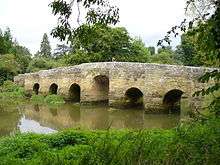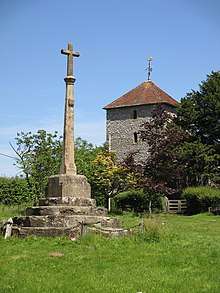Stopham
Stopham is a hamlet and civil parish in the District of Chichester in West Sussex, England, about 1.5 miles (2.4 km) west of Pulborough on the A283 road. It is in the civil parish of Fittleworth.
| Stopham | |
|---|---|
St Mary the Virgin parish church | |
 Stopham Location within West Sussex | |
| Area | 3.54 km2 (1.37 sq mi) [1] |
| Population | 87 (2001 Census)[1] |
| • Density | 25/km2 (65/sq mi) |
| OS grid reference | TQ0218 |
| • London | 42 miles (68 km) NNE |
| Civil parish |
|
| District |
|
| Shire county | |
| Region | |
| Country | England |
| Sovereign state | United Kingdom |
| Post town | Pulborough |
| Postcode district | RH20 |
| Dialling code | 01798 |
| Police | Sussex |
| Fire | West Sussex |
| Ambulance | South East Coast |
| UK Parliament | |
The parish has a land area of 874 acres (354 ha). The 2001 Census recorded 87 people living in 39 households, of whom 40 were economically active.[1]
Manor
The Domesday Book of 1086 records a manor of Stopham or Stopeham. The same family, the Bartletts or Barttelots, has held the manor since the Norman Conquest of England. Since 1875 they have been baronets.
Part of the present manor house is dated 1485, but there was a house on the site before that.[2] The house was given a new east front in the 16th century but was partly demolished in 1638.[2] Its plan is E-shaped,[2][3] a layout popular for Jacobean manor houses. The house is a Grade II* listed building.[2]
Parish church
The earliest parts of the Church of England parish church of St Mary the Virgin are 11th-century Saxon or Saxo-Norman, and the remainder of the building is 12th-century Norman.[3] New windows were inserted in the chancel in the 13th century and in the nave in the 14th century.[4] The west tower was rebuilt about 1600.[3] The east window of the chancel was inserted in 1638 but is significantly older, having been transferred to its present position from the manor house.[4] The church contains a series of monumental brasses to members of the Barttelot family:[4] three pairs from the 15th century and one set from the early 17th century.[3] The church is a Grade I listed building.[4]
St Mary's parish is part of a combined benefice with the parish of St Mary the Virgin, Fittleworth.[5]
Stopham Bridge

Stopham Bridge is a Grade I listed building[6] and a Scheduled Monument. Despite much speculation over the construction date of this ironstone bridge, the correct date is believed to be c.1422-3. One span of the bridge was destroyed during the Civil War and replaced by a drawbridge. The bridge's central arch was modified in 1822 and bears this date.[7]
The bridge carried the A283 through the village, with traffic light control being introduced in 1936.[8] The bridge was badly damaged by Army lorries during the Second World War but has been repaired since.[7]
In 1986, Stopham Bridge was replaced by a new reinforced concrete bridge, located 100 feet North of the old bridge, to alleviate the large queues which built up at this point and due to increasing levels of damage to the inside of the parapet by vehicles traversing the bridge. Due to poor ground conditions, the piers of the new bridge are supported on piles that go down between 15 and 20 metres to the sandstone bedrock.[9][10][11]
Economic history
The parish is bounded to the east by the River Arun, spanned by Stopham Bridge. There has been a bridge here since the 14th century, apparently built in 1347[12] and possibly of timber.[13] The present stone bridge has seven arches[13] and was probably built in 1422–23.[3][6] The River Rother forms the southern boundary of the parish from its confluence with the Arun below Stopham Bridge.
Lee Farm, about 0.5 miles (800 m) southwest of the village, is a timber-framed house Tudor with red brick nogging.[14] A date carved in two places on the house says either "1492" or, more likely, "1592".[14] The house is a Grade II* listed building.[14]
In the 1790s work began to make the Rother navigable to Midhurst, beginning with a canal cut from the Arun between the Rother and what is now the A283 road. The first lock was built in the grounds of Stopham House. In 1821–22 the central arch of Stopham Bridge was rebuilt much higher than the others to give enough airdraught for navigation.[6]
Stopham has a public house, the White Hart,[15] which is on the former main road at the east end of Stopham Bridge. The A283 road now bypasses the pub and old bridge on a new bridge built in the 20th century.
Stopham Vineyard was established in 2007 upon the planting of 21,000 vines on a six-hectare (15-acre) estate by its owner, Simon Woodhead.[16]
References

- "2001 Census: West Sussex – Population by Parish" (PDF). West Sussex County Council. Archived from the original (PDF) on 8 June 2011. Retrieved 22 May 2009.
- Historic England (22 February 1955). "Manor Farmhouse (1265614)". National Heritage List for England. Retrieved 4 October 2013.
- Nairn & Pevsner 1965, p. 342
- Historic England (22 February 1955). "The Parish Church of St Mary (1226926)". National Heritage List for England. Retrieved 4 October 2013.
- Archbishops' Council (2010). "Benefice of Stopham and Fittleworth". Church of England. Retrieved 4 October 2013.
- Historic England (22 February 1955). "Stopham Bridge (1226929)". National Heritage List for England. Retrieved 4 October 2013.
- Historic England. "Stopham Bridge (1005889)". National Heritage List for England. Retrieved 4 October 2013.
- Simmons, Donald (2016). Stopham Bridge, Geograph, Accessed 24 May 2017.
- Simmons, Donald (2016). The old and the new bridges at Stopham, Geograph, Accessed 24 May 2017.
- Cox, Nigel (2009). River Arun: A283 Stopham Road bridge, Geograph, Accessed 24 May 2017.
- Stopham Ancient Bridge, Engineering Timelines, Accessed 24 May 2017.
- Jervoise 1930, p. 57.
- Jervoise 1930, p. 58.
- Historic England (22 February 1955). "Lee Farmhouse (1227068)". National Heritage List for England. Retrieved 30 October 2013.
- The White Hart, Stopham Bridge
- Smithers, Rebecca (2015). Sussex vineyards in bid to put themselves on Europe's wine map, The Guardian, Accessed 24 May 2017.
Sources and further reading
- Jervoise, Edwyn (1930). The Ancient Bridges of the South of England. I. Westminster: The Architectural Press for the SPAB. pp. 57–58.CS1 maint: ref=harv (link)
- Nairn, Ian; Pevsner, Nikolaus (1965). Sussex. The Buildings of England. Harmondsworth: Penguin Books. pp. 341–343. ISBN 0-14-071028-0.CS1 maint: ref=harv (link)
- Vine, P.A.L. (1995). London's Lost Route to Midhurst The Earl of Egremont's Navigation. Sutton Publishing. ISBN 0750909684.CS1 maint: ref=harv (link)
External links
| Wikimedia Commons has media related to Stopham. |